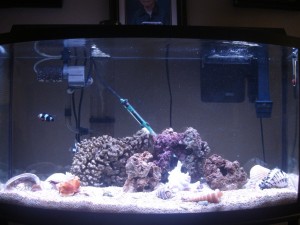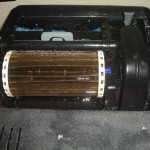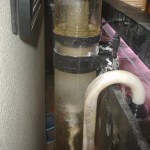The aquarium itself is a 46 gallon bow front. It’s 3 feet wide, 18 inches tall, and about a foot deep.
My wife wanted a substrate that looks like small shells, so we went with that. I didn’t do anything fancy like Dr Jaubert’s Method – just 2 inches of substrate on the bottom of the tank. So far the chemical balance is doing good, so I don’t think I really needed more biological filtration anyway.
Like I mentioned in the last post, I had 1 tiny live rock from the first run. I wanted a place for fish to hide even before we decided on the reef. So, we purchased more live rocks. Right now I think we’ve got about 30 pounds all together. It sure looks (and works) better than sandstone!
For filtration I’ve got an external filter. It’s got a snorkel that dips into the tank, but the pump and filters are all outside of the tank. It’s got some fancy “Bio-Wheel” that’s supposed to help as a bio filter – I have no idea if it actually works though.
We’ve also got a protein skimmer. This does a great job of picking up fish waste, uneaten food, and the like. It also seems to add an abundance of oxygen into the water. You can see in the picture that there is a cone of bubbles. That’s a vortex that’s created by the circular shape of the skimmer, combined with the fact that the input tube enters at an angle at the bottom of the larger vertical tube.
The water, and a little bit of air, is pushed into the skimmer by a submersible pump that’s in the aquarium. The section at the top that looks like it has a little bit of water in it is detachable so you can empty out the stuff that’s collected. The stuff gets in there by being pushed up the center tube in the bubbles. It acts kind of like an air blown popcorn machine, actually. But the result is a very clean tank. I highly recommend a protein skimmer for any marine or reef aquarium.
The lighting right now is pretty pathetic. It’s a 40 watt Normal Output (NO) T8 florescent bulb in a hood that came with the aquarium. I’ll discuss what I plan to replace it with in another post soon.
And, of course, I have a heater. Since it’s been hot for the past few months I’m actually having more trouble keeping the temperature down than up though.


